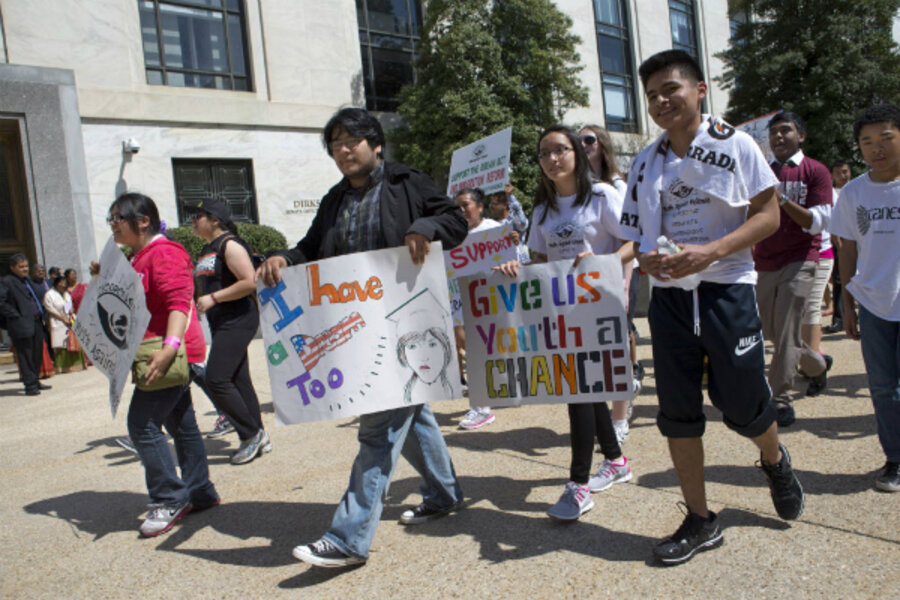DREAM Act: Senate immigration reform bill offers 'best' version yet
Loading...
| WASHINGTON
For undocumented young people brought to the US as children, the latest version of the DREAM Act won’t heal a decade-long wait for legislative relief – but it is, by far, the most generous version of the bill seen to date.
Bipartisan immigration legislation filed by the Senate’s “gang of 8” immigration reformers on Tuesday would put so-called DREAMers on a more generous fast-track to citizenship than any prior legislation and end a long-anticipated wait for legal status that has eluded the estimated 2 million such young people since the DREAM Act was offered more than a decade ago.
“It’s the best DREAM that we’ve ever had,” says Lorella Praeli, the advocacy and policy director for United We Dream, a large coalition of DREAMers that has vigorously lobbied on immigration issues.
“This is the result of years of organizing, years of sharing stories, and really dreamers have become politically popular,” says Ms. Praeli, a Peruvian DREAMer herself. “In earlier years, politicians were playing with our lives. They were so eager to trade in, to really take out things that were important for us. What you see now is the power of the DREAM movement coming through.”
DREAMers have become a political force in the immigration reform debate. Their advocacy – and work on their behalf by sympathetic lawmakers and immigration advocacy groups – helped spark President Obama’s directive last summer to shield from deportation many young people in the US illegally. Even House majority leader Eric Cantor (R) of Virginia reversed his previous view and supported a version of the DREAM Act earlier this year.
In such a climate, the Senate bill is much less restrictive in terms of its eligibility criteria and more generous in what it offers than were previous versions of the DREAM Act, according to a legislative summary of the bill and additional details provided by a Senate aide.
The Senate bill states that potential DREAMers must have been brought to the US at age 15 or before, been present in the US since Dec. 31, 2011, obtain a high school diploma or equivalent, and pursue higher education or serve in the military.
After five years, DREAMers not only will be eligible for green cards (otherwise known as a “legal permanent resident”), but also will become immediately eligible for US citizenship. That’s versus a minimum of 10 years for a green card and 15 years for citizenship for most other undocumented people.
Praeli credits Sen. Richard Durbin (D) of Illinois, the majority whip and longtime sponsor of a DREAM Act, for playing a key role in securing this five-year path to US citizenship, the fastest such route offered by any DREAM bill.
What’s gone? While previous DREAM bills restricted eligibility to those under the age of 30, the current Senate bill has no such cap. Past measures required five years of continuous residency in the US – the current measure stipulates only the time individuals must have been brought into the country and their age at that point.
This lifting of the age caps was a key DREAMer demand, Praeli says. “It is only logical that for someone who has been here since before the age of 16, but they are now 35 or 40, they have greater equities [in the US] than someone who is younger," she says. "It’s almost like logic came back to people: ‘Oh, yes, someone who has been ‘aged out’ is still a dreamer.' ”
The shift toward more generous proposals for DREAMers indicates that even opponents of the immigration reform drive are not bitterly opposed to helping young people brought to the US as children.
"They are the most sympathetic group of illegal aliens. That’s not spin, that’s correct," says Mark Krikorian of the Center for Immigration Studies, a low-immigration advocacy group. "That’s why there’s not much public opposition for the idea."
Even Mr. Krikorian, among the most hawkish analysts of immigration policy and a critic of the latest immigration reform drive, favors a narrowly tailored policy benefiting DREAMers that would lower the initial age of eligibility and bar parents of DREAMers from obtaining legal status, among other changes. The proposal includes other benefits to potential DREAMers not available in prior legislation: For one, young people who have been deported would be allowed to apply for inclusion in the policy if they would otherwise have been able to apply except for the fact of their deportation. Previous DREAM bills not only offered no hope to those already deported, but also explicitly declined to shield from deportation potential DREAMers still in the US.
For another, the Senate bill would repeal the law that some states interpret as barring the undocumented from receiving in-state tuition rates at public universities, another novel development.
And then there is the fact that DREAMers' path to citizenship is easier than for others in the US illegally. Only DREAMers and longtime agricultural workers would be able to get on a route to US citizenship without waiting for certain border security metrics to be reached.
While the vast majority of illegal immigrants in America will have to pay as much as $1,500 apiece in fines, the DREAMers will avoid most of those charges.
Those who have already been offered temporary protection – some 450,000 as of the end of March – would be “grandfathered” in to provisional legal status.
While Praeli is keen to see legislative language, the early response to the Senate draft bill from United We Dream’s supporters is upbeat. Even so, she says that backers are ready to fight for the bill all the way to Mr. Obama’s desk.
“People are saying: ‘We have fought for this, we have made this happen, we are going to fight like hell to protect it. No one better mess with this,’ ” she says.





